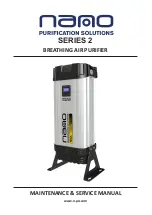
En-3
L
N
L
N
L
N
L
N
1-6. DRAIN PIPING FOR OUTDOOR UNIT
Please perform the drain piping work only when draining from one place.
1) Provide drain piping before indoor and outdoor piping connection.
2) Connect the soft PVC hose (L) I.D.15 mm as shown in the illustration.
3) Make sure to provide drain piping with a downhill grade for easy drain flow.
Note:
Install the unit horizontally.
Do not use the drain socket (1) in the cold regions. Drain may freeze and it makes
the fan stop.
The outdoor unit produces condensate during the heating operation. Select the instal-
lation place to ensure to prevent the outdoor unit and/or the grounds from being wet
by drain water or damaged by frozen drain water.
(1) Drain socket
(L) Soft PVC hose
2-1. CONNECTING WIRES FOR OUTDOOR UNIT
• Be sure to attach each screw to its
correspondent terminal when securing
the cord and/or the wire to the terminal
block.
• Make earth wire a little longer than oth
-
ers. (More than 35 mm)
• For future servicing, give extra length
to the connecting wires.
Terminal block for power supply
1) Remove the service panel.
2) Loosen terminal screw, and connect indoor/outdoor unit connecting wire
(B) from the indoor unit correctly on the terminal block. Be careful not
to make mis-wiring. Fix the wire to the terminal block securely so that
no part of its core is appeared, and no external force is conveyed to the
connecting section of the terminal block.
3) Firmly tighten the terminal screws to prevent them from loosening. After
tightening, pull the wires lightly to confirm that they do not move.
4) Perform 2) and 3) for each indoor unit.
5) Connect power supply cord (A).
6) Fix indoor/outdoor unit connecting wire (B) and power supply cord (A)
with the cable clamps.
7) Close the service panel securely. Make sure that 3-2. PIPE CONNEC-
TION is completed.
• After making connections between both power supply cord (A) and indoor/
outdoor unit connecting wire (B), be sure to fix both cable and wire with
cable clamps.
Indoor/outdoor unit connecting wire
<OUTDOOR UNIT>
35 mm
15 mm
Lead wire
Terminal block
UNIT
UNIT
Terminal block for
power supply
<INDOOR UNIT>
POWER SUPPLY
~/N 230 V 50 Hz
Service panel
Fig. 1
Fig. 2
Fig. 3
Fig. 4
Fig. 5
Fig. 6
3-1. FLARING WORK
Pipe diameter
(mm)
Nut
(mm)
A (mm)
Tightening torque
Clutch
type tool
for R410A
Clutch
type tool
for R22
Wing nut
type tool
for R22
N•m
kgf•cm
ø6.35 (1/4”)
17
0 to 0.5 1.0 to 1.5
1.5 to 2.0
13.7 to 17.7 140 to 180
ø9.52 (3/8”)
22
34.3 to 41.2 350 to 420
ø12.7 (1/2”)
26
2.0 to 2.5
49.0 to 56.4 500 to 575
ø15.88 (5/8”)
29
73.5 to 78.4 750 to 800
Tilted Uneven Burred
Good
No good
Burr Copper pipe
Spare reamer
Pipe cutter
Smooth all
around
Even length
all around
Inside is shin-
ing without any
scratches.
Flare nut
Die
Copper pipe
Clutch type
Flaring tool
Wing nut type
Copper
pipe
1) Cut the copper pipe correctly with pipe cutter. (Fig. 1, 2)
2) Completely remove all burrs from the cut cross section of pipe. (Fig. 3)
• Aim the copper pipe downward while removing burrs to prevent burrs
from dropping in the pipe.
3) Remove flare nuts attached to indoor and outdoor units, then put them
on pipe having completed burr removal. (Not possible to put them on
after flaring work.)
4) Flaring work (Fig. 4, 5). Firmly hold copper pipe in the dimension shown
in the table. Select A mm from the table according to the tool selected.
5) Check
• Compare the flared work with Fig. 6.
• If flare is noted to be defective, cut off the flared section and do flaring
work again.
3. FLARING WORK AND PIPE CONNECTION
2. OUTDOOR UNIT INSTALLATION
BH79A244H01_en.indd 3
10/15/2015 5:04:21 PM





































